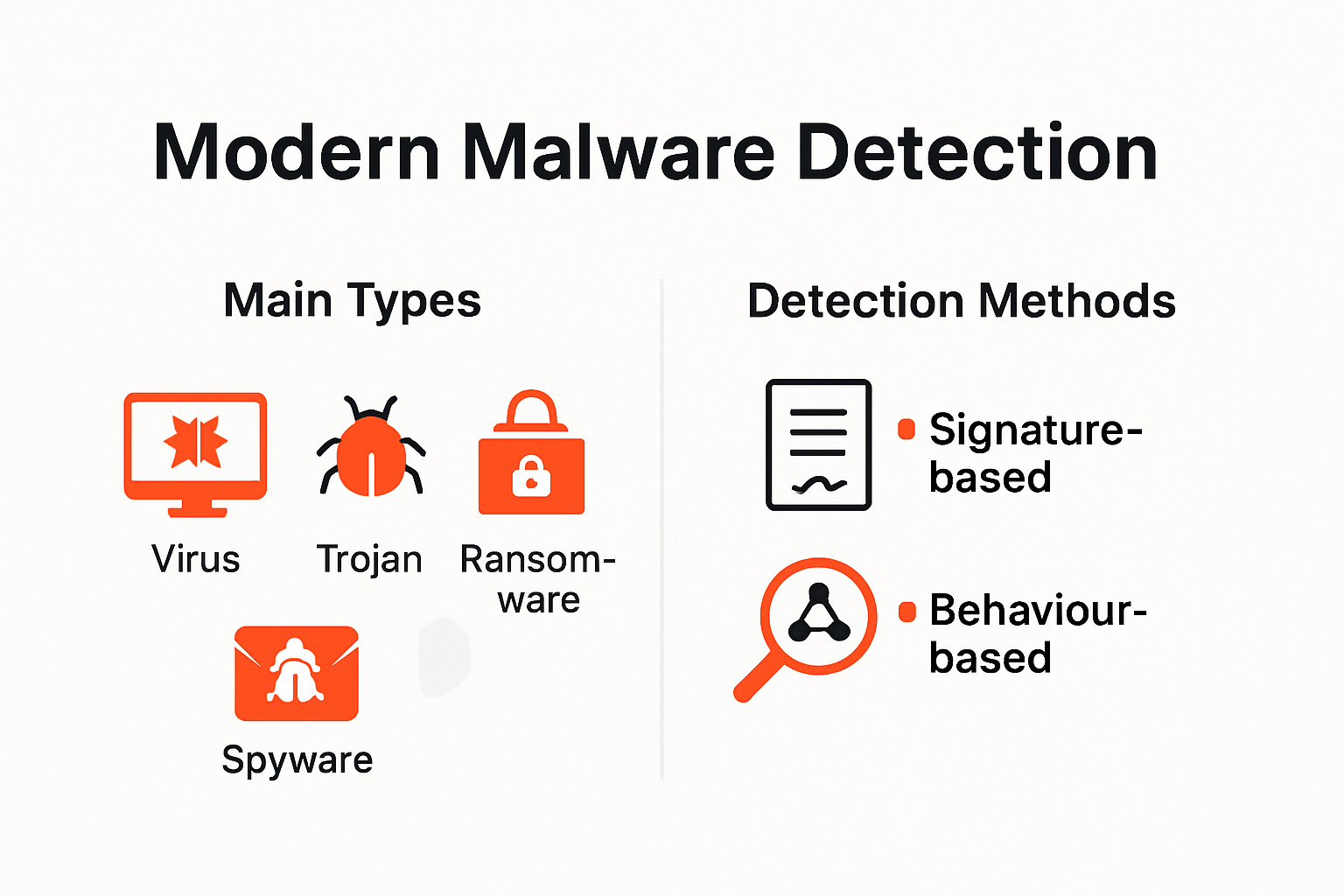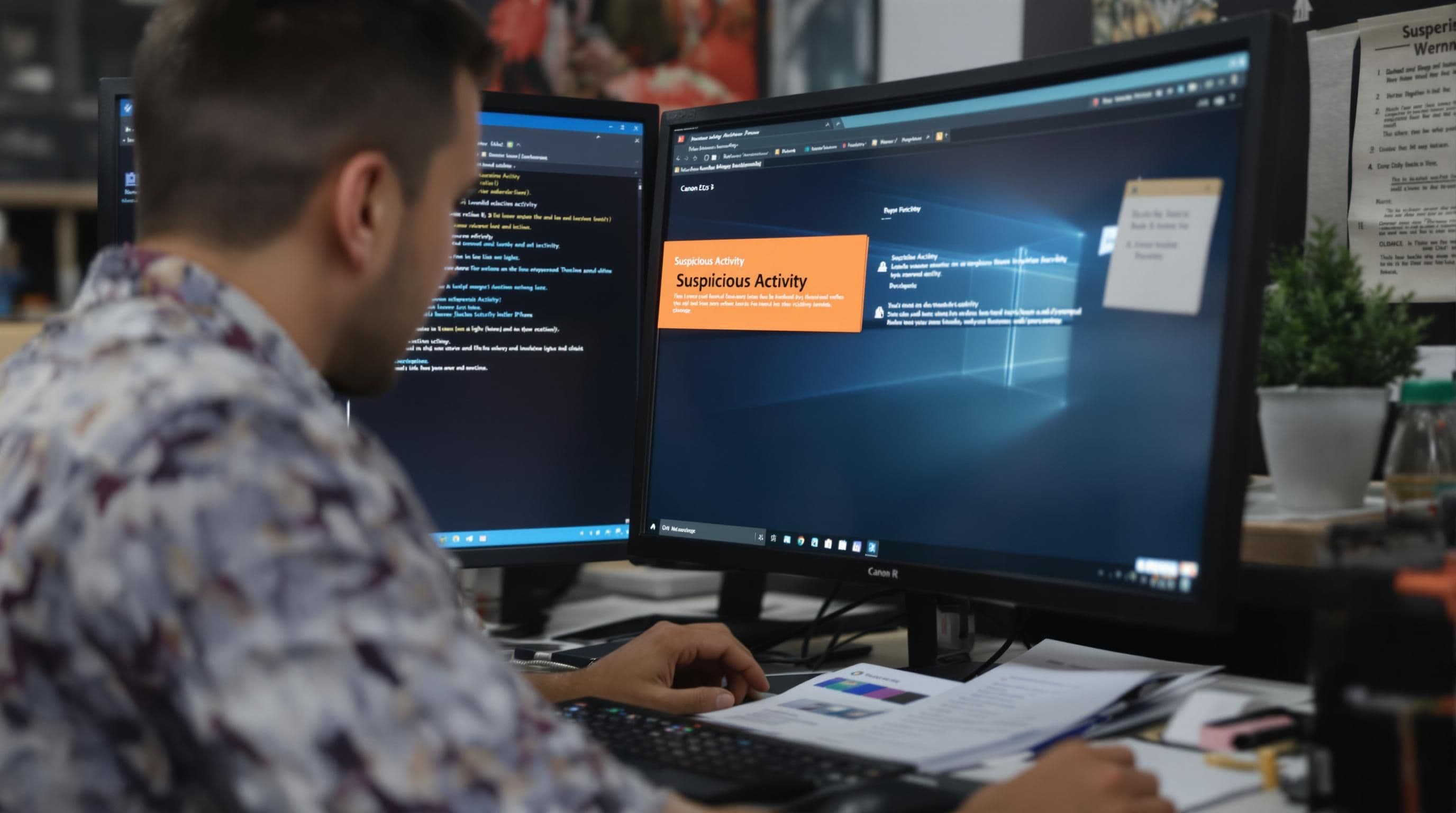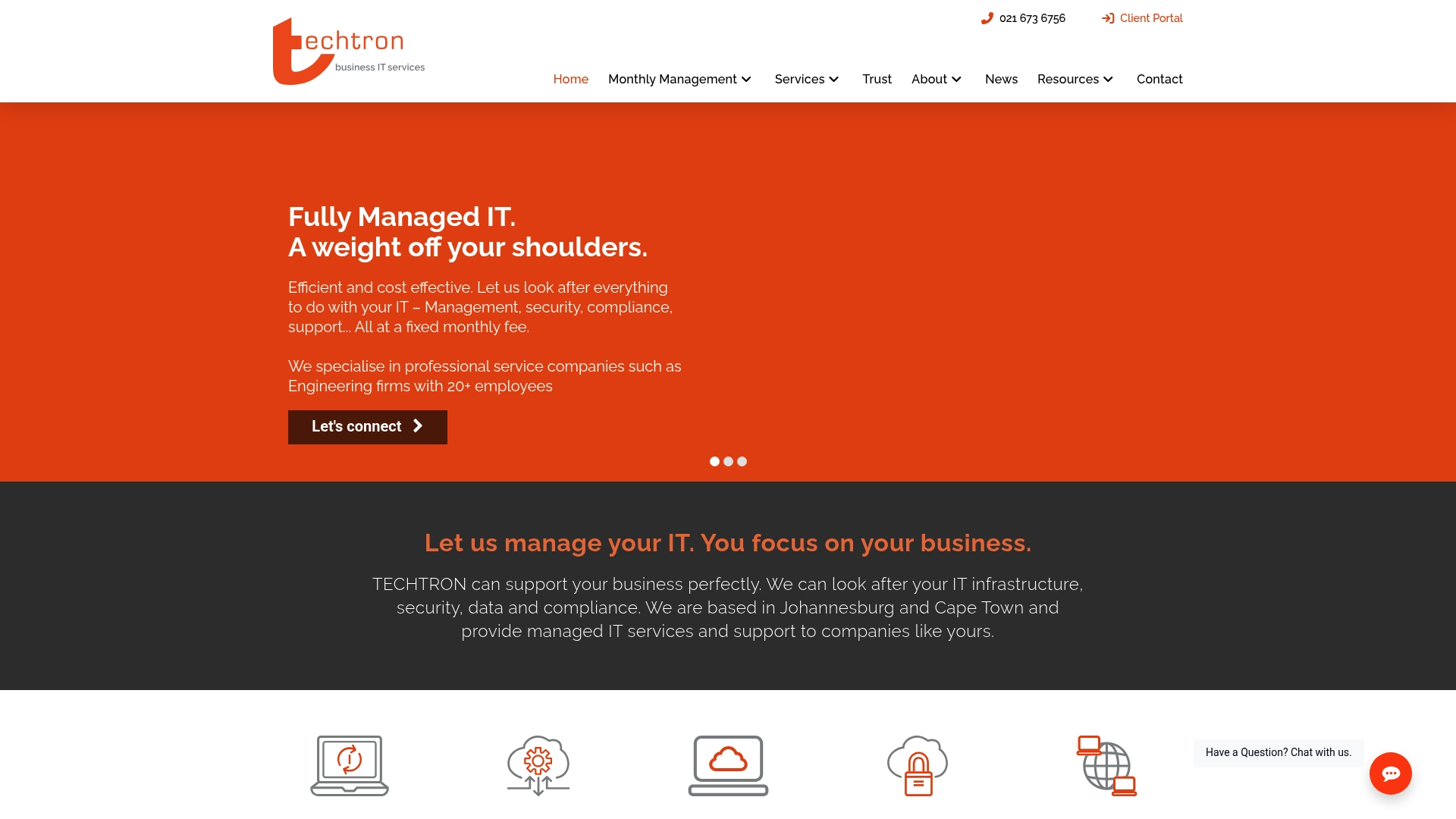How to Detect Malware: Best Practices for Businesses in 2025
Malware threats in 2025 have become nearly impossible to spot with old-school tactics. Cyber attackers now use polymorphic code and artificial intelligence, making traditional antivirus useless for most businesses. But get this. AI-powered malware detectors can identify threats with over 90 percent accuracy, leaving human analysts in the dust. What really turns things upside down is that relying on signatures alone could be the weakest link in your entire security chain.
Table of Contents
- Understanding Modern Malware Threats
- Key Signs Your Systems Are Infected
- Advanced Tools To Detect Malware In 2025
- Building A Proactive Malware Detection Strategy
Quick Summary
| Takeaway | Explanation |
|---|---|
| Move to behavior-based detection | Transition from signature-based to behavior-based detection strategies to effectively combat evolving malware threats. |
| Monitor for performance anomalies | Look for unexpected slowdowns or crashes, as these indicate possible malware infections affecting system performance. |
| Implement AI-driven detection tools | Utilize advanced AI and machine learning technologies for real-time threat analysis and to adapt quickly to emerging malware patterns. |
| Conduct continuous staff training | Regularly train employees on cybersecurity best practices and emerging threats to strengthen overall organizational security. |
| Establish a comprehensive security framework | Develop an integrated approach that combines technology, human expertise, and effective policies for resilient malware detection. |
Understanding Modern Malware Threats
Malware has transformed dramatically, becoming increasingly sophisticated and challenging to detect. Modern cybercriminals leverage advanced techniques that bypass traditional security measures, making malware detection a critical challenge for businesses in 2025.

The Evolution of Malware Complexity
Traditional malware detection methods are rapidly becoming obsolete. According to Virginia Tech’s IT Security Office, organizations must transition from signature-based detection to more dynamic, behavior-based approaches. Modern malware can mutate rapidly, disguise its code, and exploit complex vulnerabilities that static scanning tools might miss.
Cybercriminals now develop malware with extraordinary sophistication. These digital threats can infiltrate networks through multiple vectors, including email attachments, compromised websites, infected downloads, and social engineering techniques. They can remain undetected for extended periods, slowly gathering sensitive information or creating backdoors for future attacks.
Dynamic Analysis and Runtime Detection
Advanced malware detection requires comprehensive runtime monitoring. Research published in Future Generation Computer Systems highlights the importance of dynamic analysis techniques like sandboxing and memory analysis. These methods allow security teams to observe malware behaviors during actual execution, identifying malicious activities that might not be apparent through traditional scanning.
Runtime detection provides several critical advantages. It enables real-time tracking of suspicious processes, monitors unexpected system modifications, and can immediately isolate potentially harmful code before it spreads across network infrastructure. By understanding malware’s behavior patterns, businesses can develop more proactive and adaptive cybersecurity strategies.
Emerging Threat Landscapes
The malware ecosystem continues to evolve at an unprecedented pace. Emerging threats now include polymorphic malware that can change its code to evade detection, AI-powered attacks that learn and adapt to security systems, and highly targeted ransomware designed to exploit specific organizational vulnerabilities.
Businesses must recognize that malware is no longer just about viruses or simple trojan horses. Modern threats are complex, intelligent systems designed to breach even the most robust security infrastructures. Continuous monitoring, advanced detection technologies, and a proactive security approach are no longer optional but essential for organizational survival in the digital threat landscape.
To clarify the differences between signature-based and behavior-based detection approaches discussed above, here is a comparison table:
| Detection Method | Description | Strengths | Weaknesses |
|---|---|---|---|
| Signature-Based | Identifies malware by matching known patterns or signatures in files and code | Fast and efficient for known threats | Ineffective against new/variant threats |
| Behavior-Based | Observes system actions to detect suspicious or malicious behaviour patterns | Can detect unknown or evolving malware | May produce more false positives |
Key Signs Your Systems Are Infected
Identifying malware infection early is crucial for minimizing potential damage to your organization’s digital infrastructure. Recognizing the subtle and sometimes not-so-subtle indicators of a potential cybersecurity breach can mean the difference between a minor incident and a catastrophic system compromise.
Performance and Operational Anomalies
Malware often impacts system performance in noticeable ways. Unexpected slowdowns, frequent crashes, and unusual system behavior are critical warning signs. According to the National Institute of Standards and Technology, behavioral anomaly detection involves continuously monitoring systems for unusual events or trends that might indicate a potential cybersecurity incident.
Businesses should pay attention to specific performance indicators such as:
- Unexplained resource consumption: Sudden spikes in CPU or memory usage
- Mysterious network traffic: Unusual outbound connections or data transfers
- System instability: Frequent application crashes or unexpected system restarts
Unauthorized Changes and Suspicious Activities

Malware frequently leaves traces through unauthorized system modifications. NIST’s cybersecurity guidance emphasizes the importance of monitoring for unexpected changes in system configurations, files, or user permissions.
Key red flags include:
- Unexpected software installations: New programs appearing without authorization
- Modified system files: Alterations to critical system configurations or executable files
- Disabled security tools: Antivirus or firewall protections mysteriously turned off
Ransomware and Data Compromise Indicators
Ransomware presents a particularly aggressive form of malware that can quickly paralyze organizational operations. Warning signs of potential ransomware infection include:
- Sudden encryption of files with unusual extensions
- Appearance of ransom notes or communication demanding payment
- Inability to access critical system resources or databases
Businesses must remain vigilant and implement robust monitoring systems that can quickly detect these potential threats. Early detection allows for rapid response, potentially preventing extensive damage and minimizing operational disruption. Continuous training, advanced threat detection technologies, and a proactive security approach are essential in managing modern cybersecurity risks.
The following table summarises common signs of malware infection in your systems, grouped by their types for easier monitoring:
| Indicator Type | Example Signs |
|---|---|
| Performance Anomalies | Slowdowns, frequent crashes, high resource usage |
| Network Irregularities | Unusual outbound traffic, unexpected connections |
| Unauthorized Changes | New software, modified system files, disabled security tools |
| Ransomware Indicators | Encrypted files, ransom notes, access loss |
Advanced Tools to Detect Malware in 2025
The cybersecurity landscape in 2025 demands sophisticated, intelligent tools that can anticipate and neutralize complex malware threats. As digital environments become increasingly intricate, businesses require cutting-edge detection technologies that go beyond traditional security measures.
Artificial Intelligence and Machine Learning Detection
Artificial intelligence has revolutionized malware detection strategies. According to NIST’s research on Adversarial Machine Learning, advanced machine learning models can now identify sophisticated malware patterns with unprecedented accuracy. These AI-powered systems analyze massive datasets, learning and adapting to emerging threat signatures faster than human analysts.
Key capabilities of AI-driven malware detection include:
- Predictive threat analysis: Identifying potential vulnerabilities before they are exploited
- Behavioral pattern recognition: Detecting anomalous system activities
- Real-time threat intelligence: Continuously updating threat databases
Graph-Based Malware Behavior Modeling
Graph Neural Networks (GNNs) represent a groundbreaking approach to understanding malware complexity. Research published in the 2025 study on Graph Learning demonstrates how these advanced models can map intricate relationships between different malware components, providing unprecedented insights into potential threat mechanisms.
GNNs excel at:
- Complex relationship mapping: Visualizing interconnected malware behaviors
- Explainable detection mechanisms: Offering transparent reasoning behind threat identification
- Dynamic threat landscape understanding: Adapting to evolving malware strategies
Robustness and Certification in Malware Detection
Emerging techniques now focus not just on detection but on creating certified robust malware classification systems. The DRSM research on De-Randomized Smoothing introduces methods that provide verifiable defense mechanisms against sophisticated evasion attacks.
Advanced robustness features include:
- Certified defense protocols: Mathematically verifiable threat mitigation
- Adaptive classification techniques: Reducing false-positive rates
- Resilience against adversarial manipulations: Protecting detection systems from intentional subversion
Businesses must recognize that malware detection in 2025 is no longer about simple signature matching. It requires intelligent, adaptive systems that can predict, analyze, and neutralize threats with precision and speed. Investing in these advanced technologies is not just a recommendation but a critical requirement for maintaining robust cybersecurity infrastructure.
Building a Proactive Malware Detection Strategy
A proactive malware detection strategy is no longer an optional enhancement but a critical requirement for organizational cybersecurity. Businesses must transition from reactive approaches to comprehensive, anticipatory defense mechanisms that can identify and neutralize potential threats before they cause significant damage.
Comprehensive Security Infrastructure
Building a robust malware detection strategy requires a multi-layered approach that integrates advanced technologies and human expertise. Organizations need to develop a holistic security framework that combines technological solutions with strategic policies and continuous monitoring.
Key components of a comprehensive security infrastructure include:
- Integrated security platforms: Centralized systems that provide end-to-end visibility
- Cross-platform protection: Consistent security measures across all digital environments
- Scalable threat detection mechanisms: Adaptable systems that can grow with organizational needs
Continuous Training and Threat Intelligence
Human factors remain a critical element in malware prevention. Regular cybersecurity training programs are essential to educate employees about emerging threats, social engineering tactics, and best practices for digital hygiene.
Effective training strategies should focus on:
- Simulated phishing exercises: Practical training to recognize potential threat vectors
- Regular security awareness workshops: Keeping staff updated on latest cybersecurity trends
- Incident response skill development: Preparing teams to react quickly to potential breaches
Technology and Policy Integration
Successful malware detection requires seamless integration between advanced technological solutions and comprehensive organizational policies. This means developing flexible frameworks that can adapt to evolving threat landscapes while maintaining strict security protocols.
Critical integration strategies include:
- Automated threat response systems: Implementing AI-driven tools that can instantly react to potential security incidents
- Regular security audits: Comprehensive assessments of existing infrastructure and potential vulnerabilities
- Incident documentation and learning: Creating systematic approaches to analyze and learn from potential security events
Businesses must understand that proactive malware detection is not a one-time implementation but an ongoing process of adaptation, learning, and continuous improvement. By combining cutting-edge technologies, human expertise, and strategic policies, organizations can create resilient defense mechanisms that protect against the most sophisticated digital threats.
Frequently Asked Questions
How can I identify if my business systems are infected with malware?
To identify potential malware infections, look for performance anomalies such as unexpected slowdowns, frequent crashes, or unusual network traffic patterns. Monitoring for unauthorized changes and suspicious activities is also critical.
What are the best practices for detecting malware in 2025?
Best practices include utilizing AI-driven detection tools, transitioning to behavior-based detection methods, implementing continuous training for staff, and establishing a comprehensive security infrastructure.
Why is behavior-based detection more effective than signature-based detection?
Behavior-based detection is effective because it observes system actions to identify suspicious activities, making it capable of detecting unknown or evolving malware that might evade traditional signature-based methods.
How does artificial intelligence improve malware detection?
Artificial intelligence enhances malware detection by analyzing vast datasets to identify complex patterns, providing real-time threat intelligence, and adapting quickly to emerging threats, thus significantly increasing detection accuracy.
Ready to Detect and Defend Against Modern Malware?
If your business is worried about spotting advanced threats like AI-powered malware or concerned that outdated antivirus might leave you exposed, you are not alone. As highlighted in our guide on malware detection best practices for 2025, traditional signature-based tools are no longer enough. Today’s threats adapt quickly and exploit gaps before you even know they exist. Fast detection and proactive security are absolutely critical for professional service firms and mid-sized organisations who rely on the trust and uptime of their digital infrastructure.

Take control of your security with expert help. Let Techtron implement behaviour-based, AI-driven cyber protection tailored to your unique business environment. Visit our IT Security Solutions page for more on how we safeguard engineering, financial, and other growing firms against constantly evolving cyber risks. Do not wait for the next breach. Book your assessment today and build resilience with trusted managed IT support.